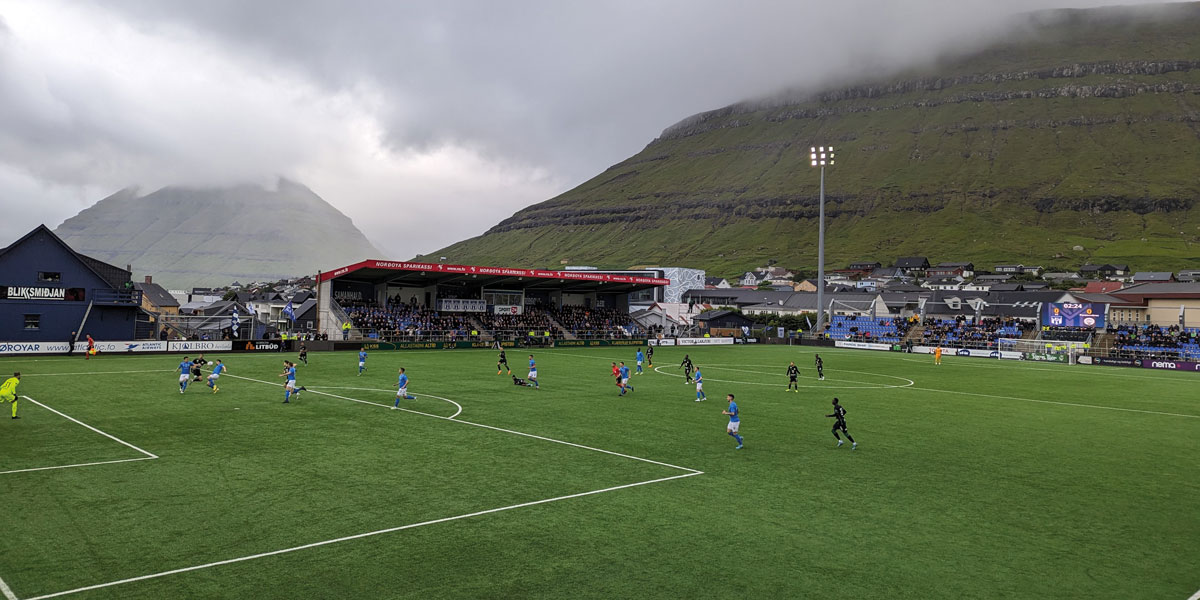Sport from Space

Posted on Dec 24, 2023 by FEED Staff
Livestreamed from the Faroe Islands, the Champions League qualifier between Faroese KÍ Klaksvík and Hungary’s Ferencváros employed innovative satellite technology
Faroese football club KÍ Klaksvík had a remarkable run last summer, making it to the third qualifying round of the 2023 Champions League – the first team from the Faroe Islands ever to do so. It all started with their first qualifier against Hungarian club Ferencváros, which was broadcast via OneWeb’s low Earth orbit (LEO) satellites.
A FOOTBALL FIRST
The match, held in KÍ Klaksvík’s Við Djúpumýrar stadium, was the first of its kind, offering live coverage from the remote Faroes to a global audience, including Paramount+ subscribers in the US. “They have no traditional satellite facilities over there,” explains Kieran Kunhya, CEO at Open Broadcast Systems. “They have been using the internet for the last five years, but are dependent on fibre optic cables, and these regularly get cut.”
Open Broadcast Systems provided C-100 encoders during the match, delivering the broadcast to football fans across the globe.
Satellite broadcasts are far from new, but they tend to be born out of necessity rather than being the ideal solution. “There have been existing older types of satellite solutions available, but these aren’t really suitable for sports,” says Kunhya. “They’ve traditionally focused on news gathering.” OneWeb’s LEO satellites preserve the signal’s quality, while offering a solution for remote locations. “Using OneWeb for sports is a game changer,” begins Kunhya. “They do sports transmissions from remote locations – cycling, golf and so on.”
As a new technology, some technical challenges are associated with LEO. “There are lots of little satellites moving in the sky instead of a few big ones in a fixed location,” explains Kunhya. “Every three minutes, you need to have a clean handover. Otherwise there will be some kind of break-up or stuttering on the live video feed.”
That said, Open Broadcast Systems had plenty of support on the ground. From the volunteer fire brigade installing a satellite terminal on the stadium’s roof, to Faroe-based Ø-Media encoding the signal. “It was a massive team effort,” enthuses Kunhya. “Everyone in the Faroe Islands was keen to play their part and help out.”
RIGHT PLACE, RIGHT TIME
Kunhya and his colleagues were waiting for the right moment to test this new satellite technology. The match between the Faroese and Hungarian teams offered just that. “I thought this game was a good opportunity,” he recounts. “It was going to lots of broadcasters around the world, and was a chance to do this in a real project, delivering a real sporting event. We offered it to Network Innovations, our OneWeb partner, a week before – and somewhat surprisingly, they said yes.”
OneWeb connected its LEO satellites to its flat panel user terminal, the Kymeta Hawk u8. This can deliver low-latency streams with a download speed of 75Mbps and an upload speed of 15Mbps.
The Kymeta is a plug-and-play solution, making it easy to install and operate without a satellite vehicle – something the Faroe Islands lacks. The terminal works with LEO satellites to deliver a reliable stream, comparable to that of a top-tier event.
“The next step would be to get high-speed connectivity from something that fits in hand luggage,” says Kunhya, after detailing the logistical issues surrounding the broadcast. “We had to take the antenna to Heathrow and it kept getting bumped off flights. There are only a few planes to the Faroes every day, and the antenna arrived on the last one. It was really tight – and it wouldn’t have happened without DHL Global Forwarding.”
ATLANTIC UNDERDOGS
Despite the match ending in a 0-0 draw, supporters from around the world watched the unfolding action, both via traditional TV channels and VOD services like Paramount+.
KÍ Klaksvík went on to beat Ferencváros on the latter’s home turf before returning to the Faroes to face – and ultimately defeat – BK Häcken from Sweden. The club used Open Broadcast Systems’ C-100 encoders for subsequent games, delivering live coverage over wired and 4G connections. “It’s remarkable for a team from a town of 5000 people to be beating national champions of other countries. The irony was that we sent the dish back, when actually it would have been useful for subsequent matches,” remarks Kunhya.
KÍ Klaksvík lost in the third round to Norway’s Molde Fotballklubb. Having come that far, the club entered the Europa League play-offs, facing Sheriff Tiraspol from the Moldovan Super League.
A NEW FRONTIER
The Faroe Islands, situated about halfway between Norway and Iceland in the North Atlantic, is undoubtedly a remote location, geographically speaking. But remote doesn’t necessarily mean unadvanced. “Everything is well organised there,” says Kunhya, “but the reality is that they do one or two international transmissions a year, so they need some technology that’s more flexible. These one-off events don’t justify a lot of expenditure.”
That said, the Faroe Islands produce tonnes of content for domestic consumption. “They have everything well above international standards,” admits Kunhya. “But the bit we’re here to help on is the international leg.”
Whether for sports broadcasting from the Faroe Islands or filmmaking in Antarctica, it’s just the beginning for LEO satellites, which have applications in all genres. “Nature documentaries are a good one, where you need to have that high level of quality, and are making a film in a remote location,” suggests Kunhya. Other areas of application might include the oil and gas sector, tourism and the military.
LEO’s other appeal? Sustainability. “There’s an incentive to do this, to not put people on planes and send them off around the world to make content,” remarks Kunhya. “Cost is obvious, but there’s a push in the broadcast industry to go green, and this can be a great way to reduce our carbon footprint.”
LEO satellites have proved useful in sports broadcasting, especially from remote locations. This plug-and-play solution will become more accessible once broadcasters realise its potential – and its physical parts become more portable.
Until then, the KÍ Klaksvík versus Ferencváros live stream suggests that, with a collaborative, coordinated team, the sky is no longer the limit.
Originally published in the Winter 2023 issue of FEED.










